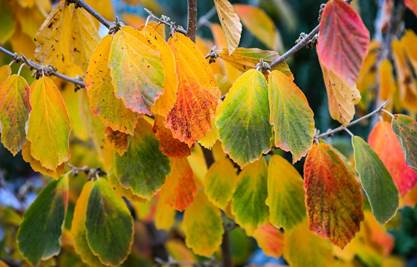Taking an environmentally sensitive approach to pest management
Fall Color from Shrubs
Published: October 7, 2019

staghorn sumac
While trees command most of our attention when it comes to fall foliage color, their more diminutive relatives should not be overlooked. In the home landscape as well as in the wild, woody shrubs also provide fall color to enhance outdoor living are as well as add beauty to the season. At a time when many summer flowers are in a state of decline, colorful shrubs can extend garden enjoyment.
Shrubs that provide fall color are not restricted to those planted in home landscapes. Many occur in nature and can be enjoyed as outdoor enthusiasts search for colorful fall scenes. Indeed, early autumn excursions are made more enjoyable by the bright red leaves of native sumacs such as fragrant sumac (Rhus aromatica) and smooth sumac (Rhus glabra) often can be seen growing along roadsides. These two species also are suitable for the home landscape and will provide good fall color additional to interest at other times as well.
Perhaps a bit more decorative, cut-leaf staghorn sumac (Rhus typhina 'Laciniata') is another useful sumac selected from a native sumac species. Capable of growing to a height of about 20 feet, it boasts large, deeply divided leaves that turn from a beautiful orange to a fiery red in the fall. It must be given room, however, since it tends to spread via root suckers to form a clump. Like other sumacs, it is durable and tolerates poor soil along with dry, sunny exposures. Tiger-eyes sumac (Rhus typhina 'Bailtiger') is yet another selection of staghorn sumac. It boasts chartreuse green foliage in the spring, yellow foliage during the summer and fiery orange foliage in the fall. Shorter than cut-leaf staghorn sumac, it grows to a height of only about six feet.
One of the most attractive and best-known shrubs for fall color is dwarf burning bush euonymus (Euonymus alatus 'Compactus'). The species is considered by some to be invasive, especially when planted in more rural settings. When planted in urban areas, 'Compactus' is much less so. Additionally, sterile 'Compactus' cultivars recently have been developed and currently are being evaluated for horticultural merit. Somewhat smaller in size than the species, 'Compactus' is considered to be more suitable for the home landscape. It prefers full sun to part-sun/shade and bears leaves that turn crimson red in fall.
One of the lesser-known shrubs that provides good reddish-purple fall color is oakleaf hydrangea (Hydrangea quercifolia). In addition to attractive fall foliage color, this hydrangea produces white flowers in early summer that turn pinkish purple by mid-summer and brown in the fall. This is possible because the showy appendages of the flowers are long-lived bracts and not petals. While it can tolerate some sun, oakleaf hydrangea may fade and color prematurely when heat stressed. Dozens of useful cultivars of the species have been selected and are available to the public. One of the best is 'Snowflake' which produces huge eight-inch panicles that often bend down the shrub's branches because of their abundance.
A group of shrubs that also exhibit modest fall color while being good landscape specimens are the viburnums. They include American cranberry bush (Viburnum trilobum), Korean spice viburnum (Viburnum carlesii) and several other related species in the Viburnum genus. Most will develop red or reddish-purple fall foliage color. Additionally, they bear attractive (and often fragrant) flowers in the spring.
Japanese barberry (Berberis thunbergii.) is a common landscape shrub that also carries with it the reputation of being invasive, especially in eastern states. Crimson pigmy barberry (Berberis thunbergii 'Atropurpurea Nana')is a dwarf form of the species which develops far fewer fruits and is considered much less of a threat to become invasive. As its common name implies, it has deep burgundy foliage the entire growing season that turns crimson red in fall.
Call them large shrubs or small trees, dogwoods are another group of woody plants that develop attractive reddish-purple fall leaf color. The shrubby types, such as silky dogwood (Cornus amomum) or red osier dogwood (Cornus sericea) are good choices for landscape use, given the proper setting. They grow from between six to ten feet in height and almost as wide. Where space is available, they make durable, low-maintenance shrubs that add beauty to the landscape. The red osier dogwood, commonly called red twig dogwood, also is grown for the reddish color of its bark which provides color throughout the winter.

common witch-hazel
While most of the shrubs mentioned thus far have red or reddish-purple fall foliage color, there are shrubs that provide other colors as well. Forsythia (Forsythia spp.) is noted for its bright yellow flowers borne in early spring. Most, however, produce yellow-green foliage color in fall. Additionally, a bright yellow leaf color is produced in fall by common witch-hazel (Hamamelis virginiana). This woody species develops into a large shrub or, at times, a small tree. In addition to yellow-colored fall leaves, this plant sometimes produces yellow flowers after its leaves have fallen. A native species, witch-hazel is not readily available in commerce, but worthy as a landscape addition, should one be found.
Colorful shrubs provide a special "finishing touch" to the landscape. No matter what your taste might be, you are sure to find a shrub that can accommodate it. Additional to those mentioned above, cotoneaster, aronia, some of the spireas and a few species of shrub-type rose are worthy of investigation.
The enjoyment of fall foliage color is one of nature's treats. Perhaps its fleeting appearance is one reason annual spectacle so highly anticipated. Shrubs, no matter how colorful, do not provide the visual impact of large trees. However, they do add another dimension to the landscape. Thus, occasionally when looking up to admire fall tree color, take time to look down and enjoy the color some of our woody shrubs provide.
Subscribe to receive similar articles sent directly to your inbox!
- Fall Color from Shrubs (10/07/19)
REVISED: October 7, 2019